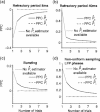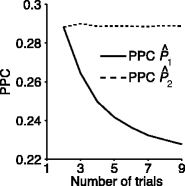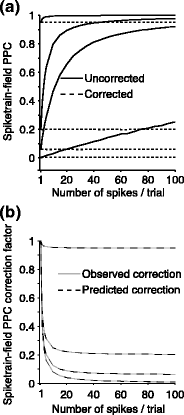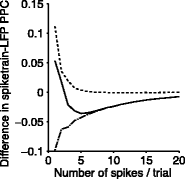Improved measures of phase-coupling between spikes and the Local Field Potential
- PMID: 22187161
- PMCID: PMC3394239
- DOI: 10.1007/s10827-011-0374-4
Improved measures of phase-coupling between spikes and the Local Field Potential
Abstract
An important tool to study rhythmic neuronal synchronization is provided by relating spiking activity to the Local Field Potential (LFP). Two types of interdependent spike-LFP measures exist. The first approach is to directly quantify the consistency of single spike-LFP phases across spikes, referred to here as point-field phase synchronization measures. We show that conventional point-field phase synchronization measures are sensitive not only to the consistency of spike-LFP phases, but are also affected by statistical dependencies between spike-LFP phases, caused by e.g. non-Poissonian history-effects within spike trains such as bursting and refractoriness. To solve this problem, we develop a new pairwise measure that is not biased by the number of spikes and not affected by statistical dependencies between spike-LFP phases. The second approach is to quantify, similar to EEG-EEG coherence, the consistency of the relative phase between spike train and LFP signals across trials instead of across spikes, referred to here as spike train to field phase synchronization measures. We demonstrate an analytical relationship between point-field and spike train to field phase synchronization measures. Based on this relationship, we prove that the spike train to field pairwise phase consistency (PPC), a quantity closely related to the squared spike-field coherence, is a monotonically increasing function of the number of spikes per trial. This derived relationship is exact and analytic, and takes a linear form for weak phase-coupling. To solve this problem, we introduce a corrected version of the spike train to field PPC that is independent of the number of spikes per trial. Finally, we address the problem that dependencies between spike-LFP phase and the number of spikes per trial can cause spike-LFP phase synchronization measures to be biased by the number of trials. We show how to modify the developed point-field and spike train to field phase synchronization measures in order to make them unbiased by the number of trials.
Figures







Similar articles
-
Unbiased and robust quantification of synchronization between spikes and local field potential.J Neurosci Methods. 2016 Aug 30;269:33-8. doi: 10.1016/j.jneumeth.2016.05.004. Epub 2016 May 13. J Neurosci Methods. 2016. PMID: 27180930
-
Adaptive spike-artifact removal from local field potentials uncovers prominent beta and gamma band neuronal synchronization.J Neurosci Methods. 2020 Jan 15;330:108485. doi: 10.1016/j.jneumeth.2019.108485. Epub 2019 Nov 6. J Neurosci Methods. 2020. PMID: 31705936 Free PMC article.
-
Introducing a Comprehensive Framework to Measure Spike-LFP Coupling.Front Comput Neurosci. 2018 Oct 15;12:78. doi: 10.3389/fncom.2018.00078. eCollection 2018. Front Comput Neurosci. 2018. PMID: 30374297 Free PMC article.
-
Challenges in the quantification and interpretation of spike-LFP relationships.Curr Opin Neurobiol. 2015 Apr;31:111-8. doi: 10.1016/j.conb.2014.09.004. Epub 2014 Oct 3. Curr Opin Neurobiol. 2015. PMID: 25282542 Review.
-
Nonrenewal spike train statistics: causes and functional consequences on neural coding.Exp Brain Res. 2011 May;210(3-4):353-71. doi: 10.1007/s00221-011-2553-y. Epub 2011 Jan 26. Exp Brain Res. 2011. PMID: 21267548 Free PMC article. Review.
Cited by
-
Mapping of functionally characterized cell classes onto canonical circuit operations in primate prefrontal cortex.J Neurosci. 2015 Feb 18;35(7):2975-91. doi: 10.1523/JNEUROSCI.2700-14.2015. J Neurosci. 2015. PMID: 25698735 Free PMC article.
-
Stimulus repetition modulates gamma-band synchronization in primate visual cortex.Proc Natl Acad Sci U S A. 2014 Mar 4;111(9):3626-31. doi: 10.1073/pnas.1309714111. Epub 2014 Feb 19. Proc Natl Acad Sci U S A. 2014. PMID: 24554080 Free PMC article.
-
Decoding of Attentional State Using High-Frequency Local Field Potential Is As Accurate As Using Spikes.Cereb Cortex. 2021 Jul 29;31(9):4314-4328. doi: 10.1093/cercor/bhab088. Cereb Cortex. 2021. PMID: 33866366 Free PMC article.
-
Goal discrimination in hippocampal nonplace cells when place information is ambiguous.Proc Natl Acad Sci U S A. 2022 Mar 15;119(11):e2107337119. doi: 10.1073/pnas.2107337119. Epub 2022 Mar 7. Proc Natl Acad Sci U S A. 2022. PMID: 35254897 Free PMC article.
-
Autistic traits, resting-state connectivity, and absolute pitch in professional musicians: shared and distinct neural features.Mol Autism. 2019 May 2;10:20. doi: 10.1186/s13229-019-0272-6. eCollection 2019. Mol Autism. 2019. PMID: 31073395 Free PMC article.
References
-
- Abeles M. Role of the cortical neuron: Integrator or coincidence detector? Israel Journal of Medical Sciences. 1982;18:83. - PubMed
-
- Adey WR, Walter DO, Hendrix CE. Computer techniques in correlation and spectral analyses of cerebral slow waves during discriminative behavior. Experimental Neurology. 1961;3:501–524. - PubMed
-
- Azouz R, Gray CM. Adaptive coincidence detection and dynamic gain control in visual cortical neurons in vivo. Neuron. 2003;37:513–523. - PubMed
-
- Battaglia FP, Benchenane K, Sirota A, Pennartz CM, Wiener SI. The hippocampus: Hub of brain network communication for memory. Trends in Cognitive Science. 2011;15:310–318. - PubMed
-
- Benchenane K, Peyrache A, Khamassi M, Tierney PL, Gioanni Y, Battaglia FP, et al. Coherent theta oscillations and reorganization of spike timing in the hippocampal- prefrontal network upon learning. Neuron. 2010;66:921–936. - PubMed
MeSH terms
LinkOut - more resources
Full Text Sources

